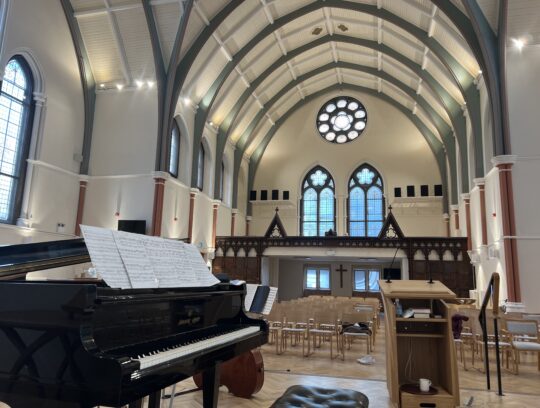
Cello and piano lunchtime recital
Date: Wednesday 08th May 2024
Time: 1pm - 1.50pm
Venue: Downing Place United Reform Church
Location: Downing Street, Cambridge, CB2 3EL
Artists: Veronica Henderson - Cello
Elizabeth Mucha - piano

Ludwig van Beethoven (1770 – 1827) – Sonata for piano and cello in D Major, Op102, No2
Allegro con brio
Adagio con molto sentimento d’affeto – Allegro fugato
Neil McKay (1947 – 2023) – Scena for cello and piano
Claude Debussy 1862 – 1918) – Sonata for cello and piano
Prologue: Lent, sostenuto e molto risoluto
Sérénade: Modérément animé
Finale: Animé, léger et nerveux
Cellist Veronica Henderson and I are delighted to be returning to Downing Place United Reformed Church in the heart of Cambridge. Our lunchtime concert will include two masterpieces of the cello repertoire, Beethoven’s last cello sonata, Op102 no 2, and the only sonata that Debussy composed for the cello. However, the talking point of this recital is a ‘lost’ work by Scottish composer Neil McKay that has been hiding in plain sight amongst my music for nearly 40 years!
McKay composed “Scena” in 1982 for Mike Spring, recently of Hyperion records, who gave me his copy sometime in the late ‘80s. Earlier this year, hearing about McKay’s death I mentioned that I had the score of “Scena”. It transpired that Mike thought that the piece was lost as a large part of his extensive music collection, together with his piano, had perished in a fire several years ago! Unbeknownst to me, Veronica also had a connection with Neil McKay as he tutored her in preparation to sit the entrance exam for Cambridge University. It seems very apt for us to be giving the world premiere of “Scena” in Cambridge!
We open our programme however with Beethoven’s sonata in D major, Op 102 no 2. This was composed in 1815 for Joseph Linke, the cellist of the famous Schuppanzigh quartet that premiered many of Beethoven’s string quartets, and Countess Anna Marie von Erdödy who was both an excellent pianist, his loyal patron and may even have been his ‘Immortal Beloved’.
In 1815 Beethoven returned to composing after a few years of ill health and personal tragedy, marking what is now regarded as the start of his ‘late’ period. His compositions from 1815 until his death in 1827 pushed the boundaries of what was considered acceptable at the time: many of his compositions from this period were met with confusion and accusations of being unplayable! The 1st movement of this sonata though demonstrates a master of sonata form at work: nothing is superfluous! The thematic material is minimal and is developed in a concise and terse manner. The substantial slow movement which follows has all the hallmarks of a ‘Beethovian’ slow movement: in turn plumbing the depths of despair then soaring on the wings of redemptive transformation. However, it is in the 3rd and final movement that we have a glimpse of where his compositional experiments would lead him in the future: an obsession with contrapuntal forms which would culminate in the Grosse Fuge, op 133 for string quartet in 1827, the year of his death. The last movement of this sonata opens with a simple scale in the cello which is repeated by the piano. The contrapuntal lines then very quickly become ever more complicated and intense as both instruments struggle to find a resolution.
We end our programme with the cello sonata by French composer Claude Debussy, intended to be the first of a set of six sonatas for different instruments. It is one of his most experimental works whilst at the same time acknowledging France’s immensely rich Baroque past. In 1915, when he composed this, he had already been struggling with the symptoms of colon cancer for several years. Made powerless by this illness to see active service in the Great War, now in its second year, Debussy’s only way to make a political statement was to compose. He confided to a friend that these were composed, “not so much for myself, but to offer proof, small as it may be, that 30 million Boches cannot destroy French thought”.
